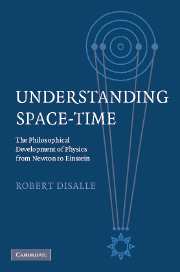2 - Absolute motion and the emergence of classical mechanics
Published online by Cambridge University Press: 22 September 2009
Summary
At a time when the relativity of motion was just beginning to be understood, Newton introduced a theory of absolute motion in absolute space and time. The controversy that then began has never ceased. What right did Newton have to explain the observable relative motions by an appeal to these unobservable entities? What role can such metaphysical hypotheses play in empirical science? By re-examining Newton's arguments for his theory, and understanding its role in the science that he helped to develop, we can see that these questions are misdirected. Newton's theory of space and time was never a mere metaphysical hypothesis. Instead, it was his attempt to define the concepts presupposed by the new mechanical science – the conceptual framework that made relative motion physically intelligible within a conception of causal interaction. Rather than an empirically questionable addition to his scientific work, it was an essential part of his work to construct an empirical science of motion. Rather than mere metaphysical baggage carried by an otherwise empirically successful theory, it was inseparable from Newton's effort to define the empirically measurable quantities of classical mechanics.
NEWTON AND THE HISTORY OF THE PHILOSOPHY OF SCIENCE
The history of Newton's ideas of space and time was once part of a philosophical justification for general relativity. For much of the twentieth century, the standard view of that history was something like this. When Newton introduced the theory, it was immediately obvious to his wisest philosophical contemporaries that this was a backward step.
Information
- Type
- Chapter
- Information
- Understanding Space-TimeThe Philosophical Development of Physics from Newton to Einstein, pp. 13 - 54Publisher: Cambridge University PressPrint publication year: 2006
